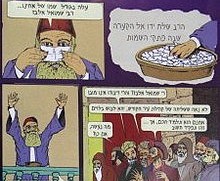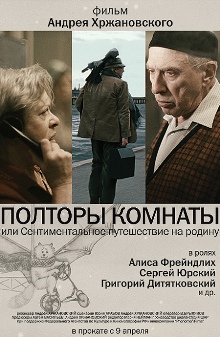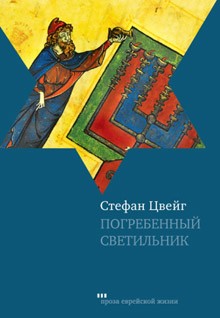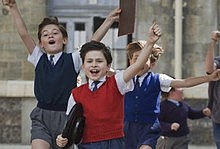Last week, Booknik visited The House That and Austria, studied Rav Kook’s theory, reported in detail on the comment party held jointly with Eshkolot in honor of Noah’s Ark and the Flood, pondered over an unusual interpretation of Joseph Brodsky’s biography, read Stefan Zweig and Alexander Sharov, applauded to Marie Dubas and Josephine Baker, and cooked meatballs a la Morocaine and tomato soup.

The House That, by Mariam Petrosyan
This is the first book by the Armenfilm Studios animation artist, who had started drawing her characters even before she wrote about them. Mariam had been working on her book for over 20 years. She wrote the first draft in the late 1980s when she was a teenager. That was the time when they discussed orphanages and handicapped children’s problems. Yet The House That is not overflowing with social sentiment of exposure so characteristic of that period’s mores, for this is not a realistic novel. At the same time, Mariam Petrosyan did not write a fantasy for young adults. The book is a brilliant and fanciful parable telling about other kids. As Borges said, every author created his or her own predecessors. Mariam Petrosyan names hers — Lewis Carroll, Rudyard Kipling, and Richard Bach. But they are by no means the only ones you might spot reading The House That. Booknik reviewer Yevgenia Ritz reads the novel, and draws some parallels, and if a reader decides to pick this book up, he or she will have to draw their own, for every species of white birds flocks together.

Religious Zionism of Rav Kook, by Pinchas Polonsky
Booknik contributor Ariel Bulstein reads the work by Pinchas Polonsky on the teachings of Rav Kook, one of the most captivating figures of contemporary Jewish renaissance. The scholar explains the basic points of the man’s legacy, the concepts of national dialogue with God, and continuous revelation, and tells about Rav’s views of the metaphysical basis for recreating the Jewish state. He treats Rav’s approaches in the light of clashing traditional rules and contemporary notions of ethics and justice.
In the Land of Far Faraway
The Calendar According to Ivan, by Alexey Ivanov
Recently, the cultural life has been separated into two categories, the one for those who watch, and another one for those who read. The Tsar project is a part of the main trend. The film by Pavel Lungin that premiered in summer at the International Moscow Film Festival, has just hit the screens, and a little before that, the book by Alexey Ivanov hit the stores. Booknik’s contributing editor Dina Suvorova reads this fable on the power that had long lost its sense of proportion, and the story she reads is the scarier the faster the myth of Stalin’s strong hand is now spun, following the authorities’ specifications of the heroic folk epos. Mr. Ivanov does not write about the confrontation between the power and the intelligentsia, he does not even describe the spiritual and secular powers’ opposition. His Metropolitan Filipp will not be able to understand dark corners of the Tsar’s psychopathic mind but will understands work, and Ivan the Terrible will never accept the calm wisdom of working people. These are two entirely different worlds, Russia of artisan common folk, and Russia of, so to speak, intellectual power elite. One feeds another, and the latter does not take the former into the slightest consideration, plunders it, and only sometimes, by omission, it lets the one under it take a breath. The first Russia does not believe in the second one. This was the beginning of this calendar according to Ivan.
…and many other foods for the soul in the Books & Reviews section.
Two and Two of All Flesh
Booknik reports on the comment party held with the Eshkolot project, also sponsored by the AVI CHAI Foundation, in honor of Noah’s Ark and the Flood. In much detail Nastik Gryzunova tells about everything that happened at the party, and in the process she tries to sort out the biblical story of Noah. It seems like this is the story about many things at the same time. The omnipresence and rare vitality of the Evil; the emergence of natural sciences; the development of shipbuilding; the vessel that shines with inner light; the chipmunk; the things we love and hate (and, subsequently, the things we are prepared to take to the Ark with us, or leave behind); the hardships of survival for even a righteous person in a large family; the melting pot, tolerance, and keeping your integrity in a multicultural world. Moreover, one cannot help but notice that no matter what people you select, sooner or later their behavior turns offensive for gods. The gods are irascible but lenient, and sometimes they are quite prepared to hint at ways of salvation for humans. These are not the only points of interest in this story, of course. The report is illustrated with a found poetry text composed of users’ answers to the question What and whom would you like to take to the Ark with you, or leave behind? that was read at the party by Booknik editor-in-chief Sergey Kuznetsov (see video). There is also the video of Semyon Parizhsky’s presentation on the emergence of alchemy from the Flood waters.
…and many other water sports in the Articles & Interviews section.

Booknik’s Parisian reporter Kira Sapgir tells about the life of French singer, actress and clown Marie Dubas who was the first to bravely mix songs and comedy in her nightly one-woman acts. She was also the first to sing in Yiddish in cabaret. Marie Dubas was the star in France and the U.S. between the wars, and several years after the second war ended she left the stage, saying, “I can’t take it anymore. My trade cost me too much.”
Comic Strips for the Internet-Challenged
Orthodox Jewish families have finally got the hang of the comic strips’ educational power. It turned out that in situations when TV, Internet, and video games are barred for children, the funnies are just what the doctor prescribed. Especially if they are drawn by someone who realizes that sex, violence, and other amoral behavior should not find a way to influence yet undeveloped minds. In this case, such a person can intelligibly and captivatingly tell kids about the religious doctrine, commandments, and the people in Israel’s history. Booknik contributing editor Anna Shkolnik reports that in September, the truly revolutionary project was launched, when Or (The Light), the first comic magazine for children of orthodox families, had its first issue out, created and published by comic artist Dror Yisrael Cohen.
…and heaps of other colorful treats in the Reports & Events section.

A Room and a Half, or A Sentimental Way Home, directed by Andrey Khrzhanovsky, 2009
In this film, sepia childhood memories are put side by side with traditional cartoon cats, the director’s trademark. Here documentary meets mockumentary, and illustrations from the Stalin era’s Book about Tasty and Healthy Food come alive. Bright tourist snapshots of St. Petersburg are combined with absurdist and surrealistic fantasies, and scenes that seem to have been lifted from the 1960s movies are supported by meditative off-screen recitals. This is the flesh of the Soviet cinema’s flesh. Tentative eroticism that verges on scabrousness seems to come straight from the Perestroyka period cinematographic trash, the humor seems to disregard all good taste, and closer to the end, the degree of crudeness skyrockets. Although the form seems to be experimental, Mr. Khrzhanovsky stands back from the vein of young Russian cinema. By turning to the past, he does not strive to put the contemporary reality to the test. He seems to actively dislike this modernity. His present-day St. Petersburg, with its traffic, advertisement, and rush of life seems to alienate the film main character, together with snippets of expats’ lives. He prefers Soviet Leningrad, and this fine point puzzles everyone who knows about no amount of love lost between Brodsky and the Soviets. Movie critic Max Tuula watches A Room and a Half, and thinks about visions of the past and present from the present and the future, about the country that never was, Joseph Brodsky’s cult, aesthetics of nostalgia, and the Soviet myth.
20 Facts about Jews and Austria
“Some non-Jewish Viennese authors discussed the number of Jews in the world, and no one seemed to know exactly how many there are. The most of them agreed that it could be about 12 million. Finally, one of them, author Egmont Colerus von Geldern shook his head and said, ‘It can’t be, I know a lot more, personally.’”
How the Austrian flag was designed? What is shown in the emblem of the Austrian city with telling name of Judenburg? What do the posters of the Jewish Theater of Austria say? Booknik’s far-flung correspondent Ariel Bulstein tells Booknik the story of Jews in Austria, and Austria’s relations with its Jews.
Add a Pinch of Caraway
Culinary expert Keren Pevzner describes Maghreb cuisine, and tells her readers about Wilhelm Hauff’s Der Zwerg Nase and the vicissitudes of its protagonist’s life. She emphasizes that Oriental cooking is an art, and explains how one can become an expert in it cooking bulghur koobideh, and meatballs a la Morocaine.
…and many other fine points of taste in the Columns & Columns section.

This Austrian writer was immensely popular in the Soviet Union, yet this book, called a legend by its author, and a parable by its publisher, has never been translated into Russian before. The Text Publishers put out the translation by Ella Vengerova, and Booknik readers now have an opportunity to read an excerpt from the story about the Holy Temple golden menorah’s adventures.
…and many other hidden treasures in the Stories & Essays section.
Abraham Begat Isaac
The Jewish Man Photo Contest features tons of images now, yet we would like to give you a chance to contribute. Send your masterpieces in, for we have decided to prolong the competition so that you could join in the race.
…and other mindless pleasures in the Contests & Quizzes section.
Café Au Lait a la Josephine
“At first, I danced to get warm, and later I realized that I was born to dance. For me, to live was to dance,” the actress confessed. She was the one who turned burlesque into a psychological weapon against racism. In our new video installment Dmitry Mishin talks about Josephine Baker, the legend of French scene, whose life can be seen as an intermittent vaudeville act — anecdotal sketches take turns with singing and dancing. She was the daughter of a Jew and a black woman, brought up in a ghetto, and she fought any sorts of discrimination all through her life. Her temperament and energy shocked, and her willpower and tenacity of purpose amazed. Her café au lait complexion instigated the massive sun-tanning fad in the 1920s. Black Venus was adored both by Bohemian aesthetes, and bourgeois establishment, and all European women of fashion imitated her. In France, she was buried as a national heroine, and one of the Montparnasse squares is named after her.
Don’t Grudge the Brew 26. Tomato Soup
There are many ways to be warm in the late fall. To prepare one, we shall need tomatoes, kidney beans, spices, and a couple of ducks. Are you ready? If they are still alive, you may set the birds free now to continue with the soup recipe taught by our charming chef Roman Gershuni. It will fight off the cold.

The Freedom Textbook for Kids
and
The Pea Man and the Simpleton, by Alexander Sharov
Sometimes it is quite a feat to explain why to be different is not that bad. In cases like that, the Pea Man and the Simpleton come to the rescue. They were invented by Soviet author Alexander Sharov who wrote books for children and science fiction, and one of the best graphic illustrators in the world Nika Goltz. Booknik Jr. tells about this book that had taught many a generation of Soviet children to be afraid of identical little men, and fight evil even though everyone around you had got used to it. We reprint the book in toto, just the way it was published in 1973, with all the wonderful pictures.

Le petit Nicolas, directed by Laurent Tirard, 2009
In France, in the very end of September the movie about Little Nicolas premiered, based on books by French author and artist René Goscinny. Our contributor Max Nemtsov’s daughter who took him to see the movie says that the Nicolas books remind her of The Denis’ Stories. And our contributor rushes to share his joy with Booknik Jr., so that no one misses the movie when it’s out in their countries.
Do You Get What I Mean?
Our expert in all things wordy Zhenya Lopatnik tells not especially grown up readers of the Tower of Babel, and how it came about that all people speak different languages.
How the Life of Goggle-Eyed Fish Got Better
Booknik Radio is on again. Booknik Jr’s editor Yana Ovrutskaya reads the tale by Natalia Povalyayeva with her sweetest voice, telling how all pond dwellers stopped teasing the Goggle-Eyed Fish for being, well, goggle-eyed.
…and zillions of other sweet nothings at Booknik Jr., also known as Family Booknik, the exquisite family web site for kids and their parents.
Surrender Dorothy! Booknik and Family Booknik are supported by the AVI CHAI Foundation.












